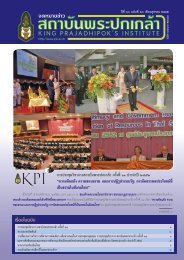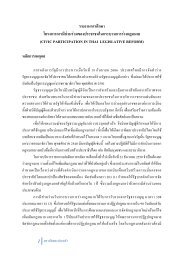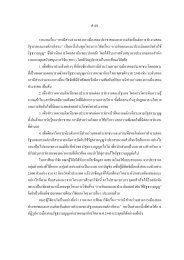SUFFiciENcy EcONOMy ANd GRASSROOtS DEvElOPMENt
SUFFiciENcy EcONOMy ANd GRASSROOtS DEvElOPMENt
SUFFiciENcy EcONOMy ANd GRASSROOtS DEvElOPMENt
You also want an ePaper? Increase the reach of your titles
YUMPU automatically turns print PDFs into web optimized ePapers that Google loves.
The Meaning of Sufficiency Economy <br />
International Conference<br />
249<br />
Distributed sources of energy, such as residential solar installations, will<br />
reduce the need for more centralized power plants by contributing power to the local<br />
grid (Cass 2011). Japan is testing other technologies to reduce urban energy demand<br />
by better integrating power and heating systems. It is spending a billion dollars in<br />
four cities in five years to develop and deploy technologies such as residential<br />
natural-gas fuel cells: the cells reduce the amount of power the grid must supply,<br />
while waste heat from the fuel cell is used to warm the house. When electricity and<br />
heat are both generated on-site in this way, a house requires less total energy than it<br />
would if warmed and powered separately. (Cass 2011)<br />
In India the annual global solar radiation is about 5 KWh/ sq m per day with<br />
about 2300-3200 sun-shine hours per year. Solar radiations represent the earth’s<br />
most abundant energy source. The perennial source of solar energy provides<br />
unlimited supply, has no negative impact on the environment. The solar photovoltaic<br />
(PV) modules convert solar radiation from the sun into electrical energy in the form<br />
of direct current (DC). Converting solar energy into electricity is the answer to the<br />
mounting power problems in the rural areas. Its suitability for decentralized<br />
applications and its environment-friendly nature make it an attractive option to<br />
supplement the energy supply from other sources. 1 KWp of SPV generates 3.5-4.5<br />
units (KWh) per day (DOT 2008). If we could install Solar Photovoltaic Cells much<br />
of the rural exchange power needs could be met, adequately cutting down harmful<br />
greenhouse gas emissions.<br />
Wind energy is another viable option. The Wind Turbine Generator is designed<br />
for optimal operation at wind speed of 10-14 m/s. The Turbine Generator starts at a<br />
cut-in speed of 3-3.5 m/s and generates power at speeds 4.5 m/s and above. In India,<br />
the best wind speed is available during monsoon from May to September and low<br />
wind speed during November to March. The annual national average wind speed<br />
considered is 5-6 m/s. Wherever average wind speed of 4.5 m/s. and above is<br />
available, it is also an attractive option to supplement the energy supply. Wind<br />
generators can even be installed on telecom tower at a height of 15-20 mt. with<br />
suitable modification in tower design, taking into account tower strength and EMI &<br />
EMC (DOT 2008). 1 KW WTG generates around 3 – 3.2 units (KWh) per day.<br />
Hybrid Wind-Solar System for the rural exchanges can make an ideal<br />
alternative in areas where wind velocity of 5-6 m/s is available. Solar-wind power<br />
generations are clear and non-polluting. Also they complement each other. During<br />
the period of bright sunlight, the solar energy is utilized for charging the batteries,<br />
creating enough energy reserve to be drawn during night, while the wind turbine<br />
produce most of the energy during monsoon when solar power generation is<br />
minimum. Thus the hybrid combination uses the best of both means and can provide<br />
quality, stable power supply for sustainable development in rural areas. These<br />
systems are specifically designed to draw 48 volts DC power output from the solar<br />
cells/ wind turbines and combine them to charge the storage batteries. The system<br />
does require availability of diesel generator, though for much reduced number of<br />
hour’s operation. It is also designed to give priority to solar and wind power so that<br />
operations of generators can be minimized to the extent possible














